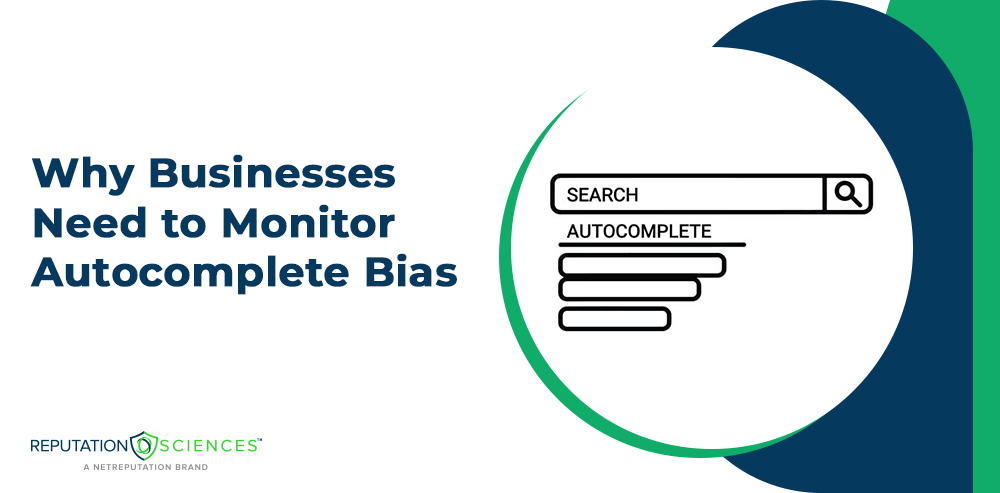Why Businesses Need to Monitor Autocomplete Bias

When customers type your brand name into Google search, they often see predictions before they finish the query. This is autocomplete at work. It utilizes patterns derived from user input, query strings, and form fields to generate suggestions in real-time. While this feature saves users time by predicting what they expect to write, it can also surface biased or misleading phrases that harm your business’s reputation.
A single biased suggestion—such as linking a company to fraud or a person’s full name to negative terms—can shift customer trust instantly. That’s why monitoring autocomplete bias has become critical for every business aiming to maintain a positive online presence.
What Is Autocomplete Bias?
Autocomplete bias happens when predictive text creates harmful or inaccurate suggestions. Instead of simply filling an input field with a street address or billing address, it suggests words or phrases that distort reality or reinforce stereotypes.
Modern browsers and autocomplete components pull data from many places, including:
- User input and form fields such as username, password, current password, and new password.
- Places API and location data, including area code, local telephone prefix, local telephone suffix, and country code.
- Search results and documents tied to previous queries and user behavior.
- Default browser features that store old values or addresses, as well as data from the user’s preferred language settings.
Because autocomplete relies heavily on repetition and frequency of searches, even a small number of biased or harmful queries can create a new value that sticks. Over time, these predictions appear valid and trustworthy to users, even when they are not.
Why Autocomplete Bias Matters for Businesses
Reputation Risk
If your brand name or key terms related to your business appear online with biased or negative autocomplete suggestions, the first impression customers get is often damaging. Autocomplete bias can connect your company to unrelated scandals, poor reviews, or phrases that undermine trust and credibility.
Customer Experience
Biased autocomplete suggestions can confuse users and damage their overall experience. For instance, if a user searches your home page and encounters predictions related to unrelated issues or negative terms, they may leave without visiting your site or engaging with your content.
Search Visibility and SEO Impact
Google search has a significant influence on customer behavior, and autocomplete suggestions can often dominate the search results. If autocomplete displays phrases that misrepresent your business, those suggestions can overshadow accurate and positive content, reducing your visibility and hurting your SEO efforts.
What Causes Autocomplete Bias?
Several factors contribute to bias in autocomplete systems:
- Algorithm Design: Autocomplete functions rely on analyzing data patterns and user input. If the training data lacks diversity or reflects societal biases, the predictions will mirror those biases.
- User Behavior: Frequent negative queries—such as “brand + scam” or “company + fraud”—become autocomplete defaults due to their volume and repetition.
- Data Limitations: A narrow dataset in an autocomplete attribute or input component can generate misleading or incomplete suggestions.
- Context and Groupings: Autocomplete sometimes groups suggestions based on prior searches or geographic location, which can unintentionally reinforce bias if not properly managed.
How Businesses Can Monitor Autocomplete
To protect your brand and maintain control over how your business is represented, a structured process for tracking and responding to autocomplete issues is essential.
- Review Search Results Regularly: Type your business name, product names, and related keywords into Google search to observe what autocomplete generates. Pay attention to both place predictions and query predictions.
- Audit Autocomplete Components on Your Website: Check form fields, login details, and address input fields on your site. Verify that autocomplete attributes and values are correctly set to expect the appropriate input type, such as username, password, street address, or billing address.
- Track Data Across Tools: Use analytics to review input field data, query strings, and customer search behavior. Understanding the context of user input helps identify potential sources of bias.
- Address Negative Predictions Proactively: If autocomplete produces harmful phrases, create valid and relevant content to push those results down. This may include blog posts, FAQs, or updated business pages.
- Use Session Tokens and Location Biasing: For businesses using the Places API or autocomplete components, implement session tokens and location bias parameters to better control the scope and relevance of predictions.
Practical Steps to Reduce Autocomplete Bias
- Use correct autocomplete attribute values for forms, such as username, password, new password, current password, tel local suffix, and preferred language, to guide browsers and autocomplete widgets in handling input fields appropriately.
- Keep customer data secure so sensitive details, such as current passwords or preferred languages, don’t surface unexpectedly in autocomplete predictions.
- Partner with reputation management experts to monitor Google search results and adjust strategies as needed.
- Update your home page, business address, and key details regularly to ensure that correct and positive information appears in autocomplete and search suggestions.
- Educate your marketing and SEO teams about the importance of context and grouping in autocomplete to avoid unintended bias.
Conclusion
Autocomplete is a powerful and helpful feature in modern browsers and web applications, designed to enhance user experience by predicting input efficiently. However, for businesses, it carries serious risks when biased or misleading autocomplete suggestions appear in Google search or on your website’s input fields.
A single biased phrase associated with your brand can damage credibility, confuse customers, and tarnish your reputation. By monitoring autocomplete attributes, analyzing user input and context, and proactively correcting harmful search results, businesses can take control of their digital identity.
Protecting your name online now requires more than accurate websites—it requires constant vigilance over the predictive systems shaping what customers see first. Maintaining awareness of autocomplete bias and implementing best practices ensures your brand remains trustworthy and visible.
